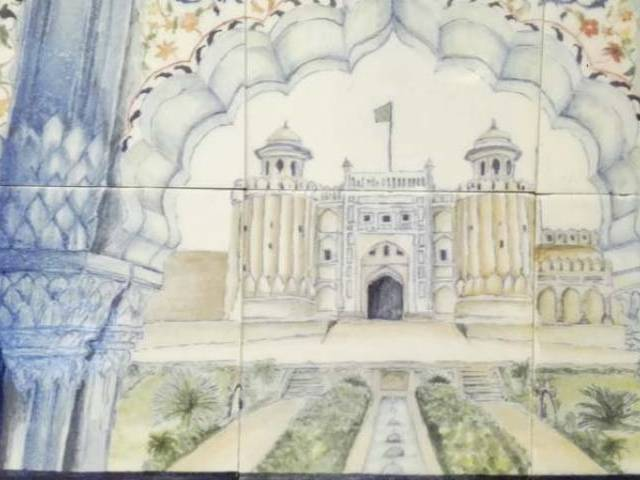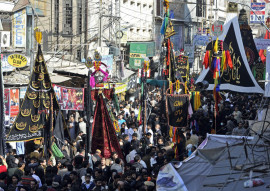
After walking through narrow alleyways, the wanderer will be greeted by a large, wooden and green front gate from where a tapered corridor, with whitewashed brick walls, leads to the inner courtyard of the haveli.
The floor of the courtyard is covered with rectangular stone tiles. On the other side, the courtyard opens into a heavily incensed living area. The walls are painted in red brick. The top floor has wooden arches, while the ground floor has vaulted wooden windows.
PML-N’s anti-govt drive ‘to start from Lal Haveli’
Green ivies and bushy shrubs dangle on the red wall. This part leads to a huge open area with white marble walls and lofty arches with a small square-shaped clean water pond having lampposts around it. It has black alams lining the wall on one side and four feet of silver tazia with intricate engravings.
The construction of the haveli was done as per the will of three brothers; Nadar Ali, Bahar Ali and Bahadur Ali. It was named after the son of Bahadur. The family remained a single unit till the time of Nawab Sahib, however, it later divided into two units; the Fakir family and Syed family.
The Fakirs, being nearest to the Darbar of Mughal, also remained in power but the other half of the family faced harder times. Moreover, the history of the haveli is also linked to the Kohinoor diamond.
The architectural design of haveli also resembles the art and culture of Mughals. The wide and long wooden doors and pillars of the courtyards are a manifestation of past glory. The kankar limestone works reflects the dedication and versatility of Mughals and Sikhs affection for art and traditional culture.
Shah Shuja Durrani of Afghanistan had to escape from his home and came to Maharajah Ranjit Singh's court for help in 1813. The maharajah kept the deposed king under house arrest in this haveli and forcefully took the kohinoor diamond, as well as other crown jewels, from Durrani. The Afghan king had to escape in disguise with his family to save his life.
Sheikh Rasheed vows to convert Lal Haveli into women university
After British the overthrew the Mughals, the haveli was returned to the Qazalbash family in 1927 and is still under the supervision of the grandsons. A major portion of the haveli was restored from the west side as it was left empty for a decade.
Speaking to APP, a shop owner at Bhatti Gate, Khurram, said all these sites represent 1,000 years of history of Lahore. “The Haveli also represents the amalgamation of different traditions which lie within the walls of Lahore. Pakistan is lucky enough that it has the privilege of a glorious past,” he added.
The renovation was done by the owners and the British rulers as a sign of the positive approach towards interfaith harmony. After the renovation, one portion of the haveli was designated as an Imambargah and the rest remained residential.
A native of the area, Khalil Sheerazi, said, “Two of the religious processions are held yearly here and culminate at Karbala Gamah Shah.” He added Mubarak Haveli is not only an architectural marvel. but has served thousands of religious pilgrims for a century.”
Published in The Express Tribune, November 26th, 2019.






















1714024018-0/ModiLara-(1)1714024018-0-270x192.webp)















COMMENTS
Comments are moderated and generally will be posted if they are on-topic and not abusive.
For more information, please see our Comments FAQ